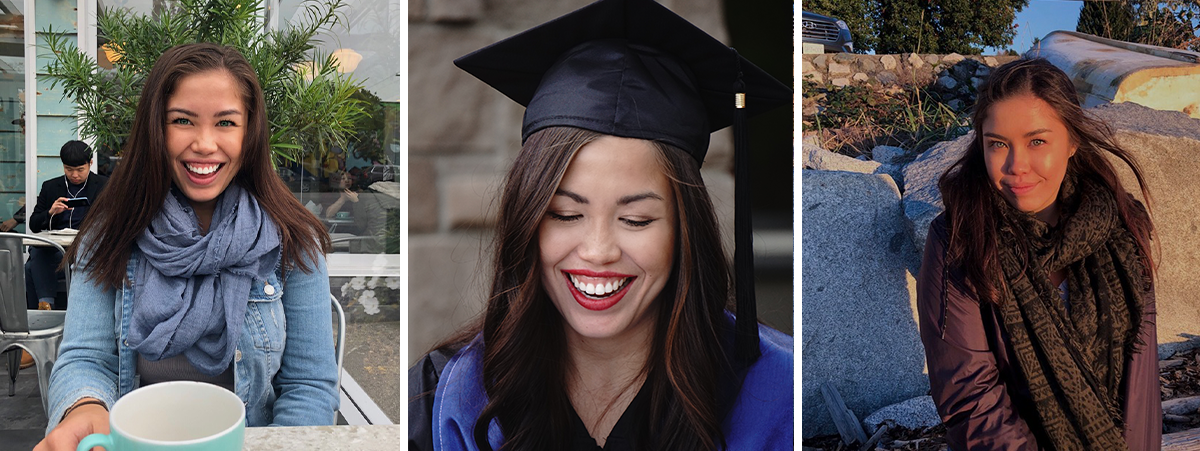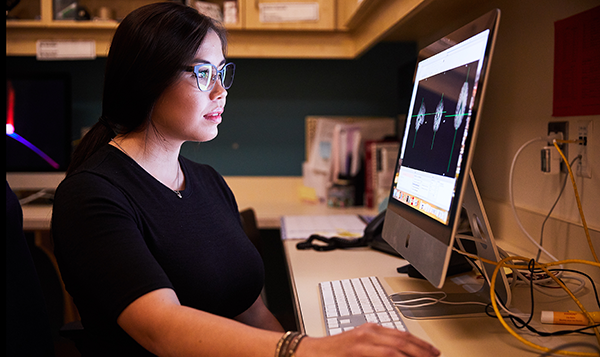Volunteer Award Winner Champions Mentorship for Indigenous Youth
Madeson Todd is fascinated by the brain. She just completed her B.Sc. at the University of British Columbia (UBC), where her studies integrated behavioural neuroscience, neurophysiology and epigenetics. “My goal is to understand the mechanisms and structures that determine human characteristics and motives,” says Todd, an Indigenous student who grew up in Calgary.
How do people think, act, and why? What leads them to certain choices? Todd is interested in this academically, however, she noticed a lack of representation of Indigenous Peoples.
“The Indigenous community is significantly under-represented in STEM,” she says. “This is substantially due to lack of exposure and unknown opportunities.”
So, she decided to create some. Todd was one of the Let’s Talk Science National Volunteer Award winners for 2020, announced this June. She earned it for her outreach efforts, which included incorporating Indigenous culture into STEM activities at UBC, and planning a pilot mentorship program for Indigenous youth.
Though the launch was delayed due to COVID and school closures, Todd wants to reach Indigenous youth in Vancouver, rural and remote B.C. and maybe even beyond.
“I love science, and have prioritized exposing resources and sharing my excitement with prospective students,” says Todd. “Through volunteer positions, I have aimed to inspire Indigenous youth to pursue academic careers in STEM beyond high school. I take it upon myself to help empower students to realize they are bright, capable, needed and, most importantly, wanted in the STEM community.”
Todd knows what it’s like to feel that support herself. At UBC, she became immersed in the Undergraduate Aboriginal Research Mentorship Program. Through it, students like her are paired with faculty members for research.
That led to two NSERC research awards for Todd, one at the Blusson Spinal Cord Centre in Vancouver, and the other at the Alberta Children’s Hospital. There, she’s evaluating brain-related structural and functional aspects of the HPA axis – our central stress response system – in relation to depression and anxiety.
The UBC mentorship program also landed Todd a role studying language development in babies, and a summer internship in Barcelona at a centre for brain and cognition.
The experiences broadened Todd’s opportunities and network. There was another key outcome. “It sparked my interest in STEM outreach, and I pursued this passion as a mentor,” she says.
Incorporating the culture
Todd became determined to coordinate events that raised consciousness about STEM possibilities that are available to Indigenous undergraduates and youth.
She was also involved in the IndigeSTEAM program at the University of Calgary, a week-long camp for Indigenous youth interested in STEM. The activities incorporated Indigenous art and culture. For example, the students made paint from raw materials, to understand the chemical process, then engineered and painted tipis that were presented to Indigenous elders.
Another UBC event she was involved in hosted John Herrington, a former NASA astronaut and the first Indigenous person to fly in space, to share his experiences with Indigenous youth. The students subsequently had to design a contraption to solve an Apollo mission problem, with limited time and supplies.
Todd was a member too of the UBC chapter of AISES, an international organization of Indigenous STEM professionals and students. The group encourages Indigenous youth to explore STEM interests.
Her activities eventually led Todd to Let’s Talk Science in 2019. She talked to Sarah Woodward from UBC’s Let’s Talk Science office about a possible program where Indigenous STEM students from UBC could serve as mentors to Indigenous high school youth. The older students would provide guidance on STEM programs at UBC, campus initiatives for Indigenous youth, and issues they might be having at school.
Woodward says that from the outset Todd had a clear vision of what this program should entail, and took the lead in creating its foundation.
“Unprompted, Madeson reached out to various organizations on campus for support and feedback on program design, including important members of the Indigenous community,” says Woodward. “Importantly, Madeson also reached out to the target audience to solicit feedback on her proposed program.”
For the pilot, Todd recruited mentors at UBC through the AISES community. As partners in the initiative, she also enlisted Geering Up (UBC’s engineering outreach) and STEM Fellowship (a not-for-profit that uses mentorship and experiential learning).
The program was to run March to June 2020, for students in Grades 8-10. The UBC student mentors were to visit the younger students biweekly, engaging them in hands-on activities, and holding small group discussions around high school and university life. The plan was then to have the younger students visit UBC in June for group activities, exposure to resources for Indigenous students, and meetings with UBC admissions staff.
COVID changed the timeline. Now, depending on school policies and COVID’s path, Todd hopes to re-start the pilot in the fall or perhaps the new year, either face-to-face or virtually. As she’ll be in Calgary, she wants to recruit another coordinator to carry it through. With Todd’s efforts, the foundation is in place.
“I hope it’s established enough and has enough momentum so it can keep going,” says Todd.
She hopes to create “a safe place where Indigenous youth can speak freely with people who understand their culture.”
Todd says she wants students to be able to exercise their scientific and analytical minds with creative, hands-on applications, while incorporating their cultural background.
“Madeson’s approach to education is that it should be accessible to all, and should respect and acknowledge the cultural history of Indigenous students,” says Woodward.
Artistic and scientific aptitudes come together
How has Todd honed her approach to outreach? She says her upbringing taught her to be innovative when developing activities. “With my life-coach mother and engineering father, I grew up exercising creative and critical thinking skills, which were nurtured through my education. I was pushed to think independently and creatively, and to intertwine my artistic and scientific aptitudes. I apply these skills when participating in and organizing activities.”
Working with Let’s Talk Science Outreach, her other volunteer positions at university, and her studies have all enhanced her understanding of and approach to how Madeson teaches.
“My science degree focusses on brain function. I’ve learned how different brains are receptive to different styles of learning. While one student may be more receptive to verbal learning, others prefer visual presentations. Being curious and open-minded to my audience in this way helps me find creative ways to share information. Additionally, my involvement in the Indigenous community opened my eyes to sharing knowledge by incorporating one’s traditions for a relatable and unique experience.”
Todd’s efforts have generated notice. “Madeson is precisely the type of student which I believe typifies Indigenous success on campus,” says Joel Liman, Senior Advisor and Recruiter – Indigenous Students at UBC’s Faculty of Science.
Woodward too has been impressed. “Madeson has shown a leadership, drive and dedication to Let’s Talk Science above and beyond that of any volunteer that I’ve worked with in my seven years as a Let’s Talk Science volunteer and coordinator,” she says.
“Overall, I feel that Madeson embodies the mission of Let’s Talk Science: to encourage youth in STEM and remove barriers that exist to post-secondary education through programming that is fun, engaging and meaningful,” says Woodward.
Equitable access to STEM
The program that Todd envisioned fits perfectly with Let’s Talk Science’s commitment to ensuring equitable access to STEM and to its programs for youth in Canada.
Let’s Talk Science has been collaborating with Indigenous communities since 1994. Based on its research on barriers to entering STEM fields, Let’s Talk Science knows how important it is for young students to see themselves represented in these fields.
The organization’s youth outreach strategy is guided by a National Indigenous Advisory Council. Let’s Talk Science also provides specialized training for all outreach coordinators and volunteers who work in Indigenous communities.
In 2019, Let’s Talk Science introduced a new training program, guided by the Truth and Reconciliation Commission’s Calls to Action, to provide staff and volunteers with a new level of knowledge and understanding of Indigenous histories, worldviews and perspectives.
“Let’s Talk Science has been incredibly supportive,” says Todd, who is now embarking on a Master’s in biomedical technology at the University of Calgary.

